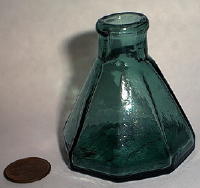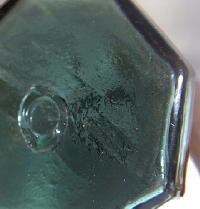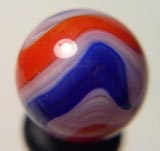Currencies
Information
More Information
Bottles and Insulators
Tips for Identifying and Valuing Bottles and Jars
Bottle valuation
Values of bottles are determined by a variety of factors including age, rarity, demand, manufacture method, advertising and use, glass color, presence of a label, and eye appeal. Unless your bottle has a label or words embossed upon it which can be researched online, the biggest challenge facing the novice collector will be identifying the age of the bottle and its type or use.
This wide-bottom octagon-shape bottle is easily identified as an ink bottle.

The open pontil scar on the bottom of the ink bottle shown above places its likely age as before 1870.
Shape
Often you can tell what a bottle was used for by its shape. For example, soda water and beer have distinctive shapes that were rarely used for other products. Another category easy to identify are the ink bottles. On the other hand, most food and cosmetic jars differ from many other pieces of glass, but it is generally difficult to tell them apart without embossing. For the most part, bottle collecting has focused on the easier to identify bottle types with known contents. The exception to that rule is that handmade bottles finely made, any unusual shape or color old bottle, or a bottle with pleasing aesthetic qualities, will always be sought after.Besides identifying the contents by the shape of a bottle, you can also estimate its age by certain features of the design. For example, some bottles, especially 19th century to early 20th century soda and beer bottles have a blob-top. This was a large blob of glass at the mouth of the bottle that formed a good anchor for wiring down the cork or stopper.
Estimating the age of a bottle by manufacturing techniques
One of the most important clues for evaluating the value and age of a bottle is determining whether the bottle is machine made, or partly or entirely made by hand. Two terms often seen to describe these bottles are ABM bottles, for "Automatic Bottle Machine" and BIM or BIMAL for "Blown in mold, applied lip" bottles. Most Bottles were entirely machine made after 1910. Most bottles were entirely hand made before 1890. The period in between includes some interesting hybrids of the two methods.Among handmade bottles, certain techniques for hold and gathering the glass changed over the time. The most important identifying feature of the antique bottles is the pontil or scar, on the base of the bottle. These scars were made when the glass tipped pontil rod (which is used to hold molten glass while it is worked) was removed. Pontil scars are generally found on utilitarian bottles until about 1870. [Keep in mind that pontil scars are still found on modern-day artisan made or boutique glassware pieces.]
Pontil marks may be open rings or solid disks. Open pontil marks can be highly variable in appearance and were made by the same type of blowpipe used to make a bottle. Iron pontils were solid disk that often left a metallic residue on the glass. Other pontils include sand pontils and glass tipped pontils.
Bottle Age

Bottle of Jaynes Eucol Spray circa 1910
Bottle Labels
The presence of labels adds a high premium to any bottle. Dug bottles have long lost their labels, and labels on kept bottles are usually washed off when reused. Anytime an old bottle has a label, it has value. Bottles with labels are also cross collectibles. Persons with no interest in bottles may purchase one with a label because of the advertising, unusual graphics, or because the subject relates to a field that interests them (e.g. old medical cures).Helpful Links
Information About Bottles, Jars, and Insulators
Below are some great links we have discovered on the web that can help you identify marks and codes to establish the age of vintage and antique items. When you click the link, you will leave our website. If you want to return, click the back button on your browser.
Antique bottle closures
Antique bottle price list
Collecting Antique fruit jars (hoosierjar.com)
BLM/SHA Historic bottle site
Collectors Weekly Bottle collecting page
Bottle Typing-Shapes Page
Bottle Collector's Haven
FruitJars.org Homepage
Glass Bottle Marks
Glass Factory Marks on Bottles, Pg3
MyInsulators.com
Antique-bottles.net
Collecting Medicine bottles
Milner Article (pdf): Fruit jars, a history worth remembering
Antique Fruit Jars
More Bottle Marks - USA
Wheaton glass history
Ink Bottles
Historic Glass Bottle Identification & Information Website
California State Parks Type Bottle Collection
Museum of historical bottles
Glassworks Auctions
Ink Bottles
Chlorox Bleach Bottle Guide

 Buy Akro Agate Popeye marbles on eBay!
Buy Akro Agate Popeye marbles on eBay!